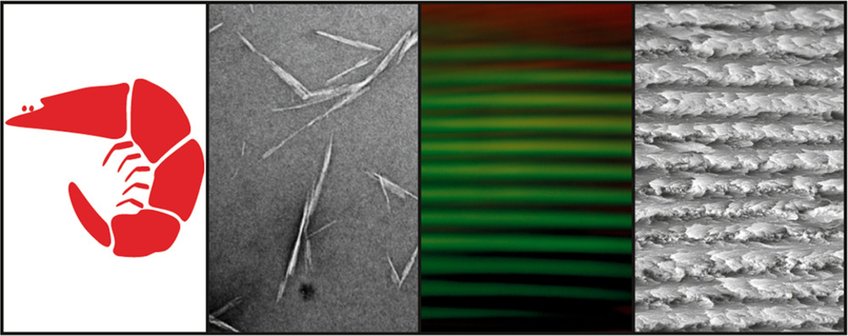
Chitin Nanocrystal Self-Assembly

Chitin is the second most abundant biopolymer on Earth, found in many living organisms but predominantly in the exoskeletons of arthropods, mollusks, and fungi. Its chemical structure is a sugar-based polymer, often arranged in semi-crystalline fibres in living organisms. Biologically, it serves various purposes, from providing structural support, such as in the cell walls of fungi and the cuticles of crabs, to forming photonic structures that create the most spectacular colours in beetles. In combination with proteins, chitin form fibres arranged in helical structures that enhance structural properties in marine crustaceans, such as the dactyl clubs of the mantis shrimp, Odontodactylus scyllarus. Several species of beetles, such as Cetonia aurata, use similar strategies to create vibrant and metallic colours by arranging chitin fibres into photonic structures that reflect visible light.
Commercially, chitin is largely sourced from the marine food industry as a waste product from crustacean shells, with the inedible exoskeleton accounting for approximately 60% of the total crustacean mass. Similarly to cellulose, chitin nanocrystals (ChNCs) can be extracted from biomass by acid hydrolysis, resulting in rod-like nanoparticles that form a stable colloid in water. When colloids are concentrated by water evaporation, the chitin nanocrystals spontaneously assemble into a periodic, well-ordered, hierarchical chiral structure. This arrangement is generated by the liquid crystal behavior of the ChNC colloid and is called chiral nematic phase.
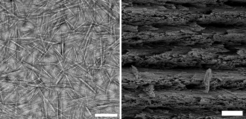
If water is entirely evaporated, a solid film of chitin with an internal helical structure is produced. While periodicity can vary from several microns to hundreds of nanometer, fine-tuning the periodicity of the helical structure, achieved by controlling the self-assembly process, can lead to the formation of a photonic structure capable of reflecting specific wavelengths of visible light. To enhance reflectivity, the film is partially transformed into chitosan. The material produced exhibits colours spanning the entire visible spectrum.
However, despite many similarities to cellulose, such as being highly abundant, biodegradable, and capable of forming photonic structures, the potential of sustainable chitin-based photonic materials has yet to be fully realized.
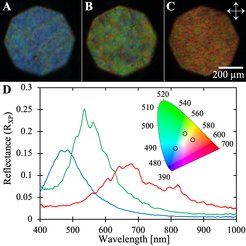
Current challenges
Although the stunning iridescence observed in beetles is known to result from the hierarchical arrangement of chitin fibres, such high reflectivity has not yet been successfully replicated in the laboratory. It is understood that, in the biological matrix, chitin is produced in combination with proteins and other substances, whereas artificially produced films consist solely of pure chitin. Chitin itself has a lower intrinsic birefringence than cellulose, which may explain why helical, self-assembled films of chitin nanocrystals with a pitch in the visible wavelength do not produce vibrant colours akin to those seen in cellulose nanocrystal films or in living organisms.
In light of this, several methods are being used to enhance this visible vibrance. Topics include:
- Doping of ChNC suspensions to create composite material
- Deacetylation of ChNCs towards chitosan nanowhiskers
- Experimentally measuring optical properties of chitin and chitosan films
ChNCs also possess abundant primary amines which can further be increased through sequential deacetylation. This unique functionality imbues ChNCs with multiple additional functionalities as opposed to cellulose nanocrystal such as
- Metal nanoparticle stabilisation
- Inherent antibacterial and antioxidant properties
- Hydrogel formulation and drug delivery
Related publications
Structural Color from Cellulose Nanocrystals or Chitin Nanocrystals: Self-Assembly, Optics, and Applications
B Frka-Petesic, TG Parton, C Honorato-Rios, A Narkevicius, K Ballu, Q Shen, Z Lu, Y Ogawa, JS Haataja, BE Droguet, RM Parker and S Vignolini – Chemical Reviews (2023) 123, 1259
(DOI: 10.1021/acs.chemrev.2c00836)
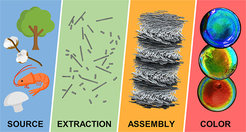
Revealing the Structural Coloration of Self-Assembled Chitin Nanocrystal Films
A Narkevicius, RM Parker, J Ferrer-Orri, TG Parton, Z Lu, GT van de Kerkhof, B Frka-Petesic, S Vignolini – Adv Mater (2022) 34, e2203300
(DOI: 10.1002/adma.202203300)
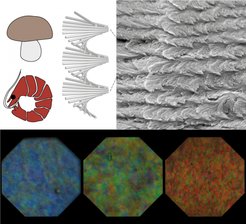
Controlling the Self-Assembly Behavior of Aqueous Chitin Nanocrystal Suspensions
A Narkevicius, L Steiner, R Parker, Y Ogawa, B Frka-Petesic, S Vignolini – Biomacromolecules (2019) 20, 2830
(DOI: 10.1021/acs.biomac.9b00589)






